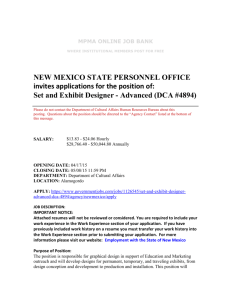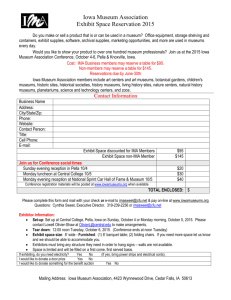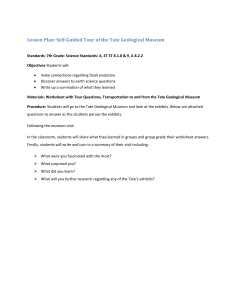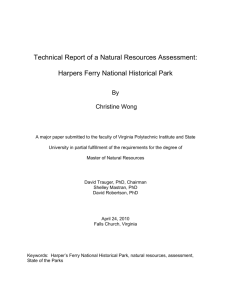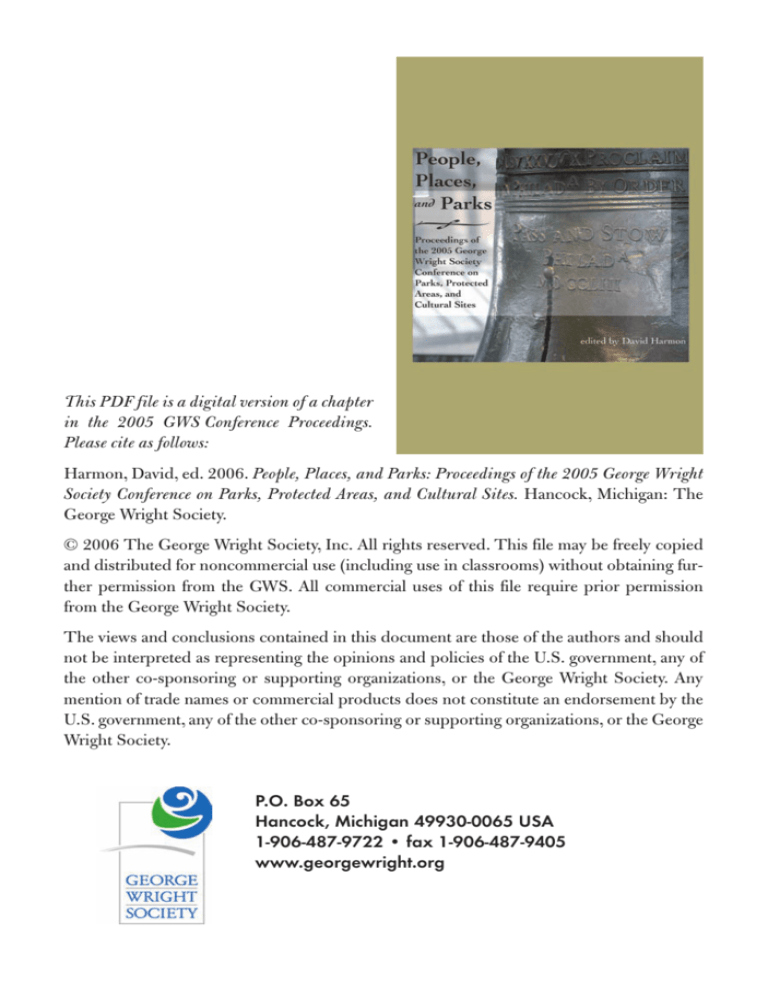
This PDF file is a digital version of a chapter
in the 2005 GWS Conference Proceedings.
Please cite as follows:
Harmon, David, ed. 2006. People, Places, and Parks: Proceedings of the 2005 George Wright
Society Conference on Parks, Protected Areas, and Cultural Sites. Hancock, Michigan: The
George Wright Society.
© 2006 The George Wright Society, Inc. All rights reserved. This file may be freely copied
and distributed for noncommercial use (including use in classrooms) without obtaining further permission from the GWS. All commercial uses of this file require prior permission
from the George Wright Society.
The views and conclusions contained in this document are those of the authors and should
not be interpreted as representing the opinions and policies of the U.S. government, any of
the other co-sponsoring or supporting organizations, or the George Wright Society. Any
mention of trade names or commercial products does not constitute an endorsement by the
U.S. government, any of the other co-sponsoring or supporting organizations, or the George
Wright Society.
P.O. Box 65
Hancock, Michigan 49930-0065 USA
1-906-487-9722 • fax 1-906-487-9405
www.georgewright.org
An Interpretive Media Perspective
Neil Mackay, National Park Service, Harpers Ferry Center, Harpers Ferry, West Virginia
25425; neil_mackay@nps.gov
At a conference at Grand Canyon regarding the state of museum work in the National
Park Service, attendees hear of “the need for complete museum records, more adequate
housing for exhibits and collections, still better exhibits, and more studies of their effectiveness.” The date is 1940, as recounted in Museum Curatorship in the National Park Service
1904–1982 by Ralph Lewis (1993:106). The same concerns are still present today, but so is
the desire to address them creatively.
There is, indeed, a legacy of museum innovation in the National Park Service (NPS), as
documented in Lewis’s work, in Interpretation in the National Park Service by Barry Mackintosh (1986), and, most recently, in Interpretive Centers: The History, Design and Development of Nature and Visitor Centers by Michael Gross and Ron Zimmerman (2002). While
these works document how the planning, design, and fabrication of museum exhibits has
progressed in the NPS over the past hundred years, many challenges remain for the numerous exhibitions spread out across the country. In the pursuit of innovative solutions to these
challenges, exhibit developers continue to collaborate, make connections with park
resources, explore new tools and processes, and reach wider audiences.
Collaborating for innovation
The history of NPS museums is one of ongoing and evolving collaboration among
museum professionals (Figure 1). The first park museums were created at the beginning of
the 20th century by ranger-naturalists and park partners responding to the growing demand
for nature exhibits by the visiting public. Early on, the NPS partnered with the American
Association of Museums (AAM), which established a Committee on Museums in the Parks
in 1924.
In the 1930s, funds became available for NPS museums from New Deal programs such
as the Civilian Conservation Corps and the Works Progress Administration. Dozens of park
museums were created by exhibit workers from the Eastern and Western Museum Laboratories. The very term “museum
lab” implies that innovation was
expected. The media approach at
that time is described in the pioneering 1941 book Field Manual
for Museums: “…the park as a
whole may be regarded as an
exhibit and the museum as an
Figure 1. NPS Western Museum Laboratory, Berkeley,
California, 1937. Photo by Nix [not further identified]. Photo courtesy of National Park Service Historic Photograph Collection, Harpers Ferry Center.
The 2005 George Wright Society Conference Proceedings • 427
explanatory label” (Burns 1941:2). As Barry Macintosh notes, this vision often led to a “narrative approach in exhibit design” (1986:48).
Then came Mission 66. Between 1956 and 1966 the NPS built over 100 new visitor
centers to meet the growing need to provide services for an increasing number of visitors to
the national parks. As the centerpiece of the park interpretive program, the Mission 66 visitor center employed expanded and refined exhibit techniques, including dioramas, relief
models, and audiovisual programs (Gross and Zimmerman 2002:32–33).
Ralph Lewis describes a key moment in media collaboration in 1955. The National
Park Service conducted an experiment in teamwork by having the exhibit designer travel to
a park—Grand Canyon—to work with the curator from the beginning of the project. The
experiment was deemed a success, not just in being more efficient, but in increasing the quality of the exhibits (1993:143). This set in motion an important media collaboration trend
that continues today: the desire to involve more participants, and to do so earlier in the development process.
By the end of the Mission
66 period in the mid-1960s,
audiovisual programs and
publications were assuming
more of the narrative story, and
exhibitions became less linear
and more concerned with giving visitors impressions and
park meanings (Mackintosh
1986:48). In 1970, this led to
another innovative concept:
housing the various interpretive media developers under
Figure 2. Model of Harpers Ferry Center, Harpers Ferry, West Virginia, 1967. Photo by M.
Woodbridge Williams. Photo courtesy of National Park Service Historic Photograph Collec- one roof by creating the Intertion, Harpers Ferry Center.
pretive Design Center at the
Harpers Ferry Center in Harpers Ferry, West Virginia (Figure 2). Creators of park brochures,
indoor and outdoor exhibits, historic furnishings, slide shows, audio programs, movies—all
would work out of the same office to achieve something greater than if they pursued their
work separately. The center also established guidelines and standards, such as conservation
protocols for developing preservation-responsible exhibits.
Today, Harpers Ferry Center employs a mix of about 180 interpretive planners, designers, filmmakers, curators, cartographers, conservators, project managers, writers, planners,
and associated administrative staff and managers. The intent is to work on interdisciplinary
teams, from the beginning of a project to its completion. Harpers Ferry Center seeks innovative ways to increase the interpretive media capacity of the NPS by collaborating with fieldbased media staff.
Knowing what to be innovative about
So, the National Park Service has collaborative media teams ready to be innovative—but
428 • People, Places, and Parks
innovative about what? It is useful to go back to our roots. Herman Bumpus, director of the
American Museum of Natural History, and head of AAM’s early park efforts, stated that
“[t]he real museum is outside the walls of the building, and the purpose of the museum work
is to render the out of doors intelligible” (Gross and Zimmerman 2002:28). In the National
Park Service, it is our relationship with the landscape and resources that drives our mission
to both protect and interpret. Therefore, some of our most important interpretive media
innovations concern providing visitors with a sense of place.
Flat maps, dioramas, murals, relief models—all have been used in NPS exhibits to help
visitors make connections with the resources, plan their visits, and better understand their
parks.
We continue to employ relief models in visitor centers, but often in new ways or using
new technologies. At Harpers Ferry National Historical Park, an important goal of the
exhibits is to give visitors a sense of how the use and look of the land has changed dramatically over time. A monochromatic relief model shows the hilly terrain of Harpers Ferry,
bounded by the Potomac and Shenandoah Rivers. Touching different locations on the
model activates video clips that present historical snapshots and brief descriptions. Today, a
relief model might even be located outdoors, such as a touchable model at the new transportation center at Zion National Park, under a shade structure accompanied by other interpretive panels and touchable models of park fauna.
Two-dimensional maps are increasingly emulating the three-dimensional world. Traditional maps and panoramic paintings were done by hand. Today, at the center’s cartographic office, innovative digital elevation models, or DEMs, are creating new techniques for visualizing terrain (Figure 3). With base data in place, these three-dimensional models can be
manipulated to tell more stories about the land. Artwork can depict how terrain changes over
time. For example, a volcano in what is now southern Oregon transforms into the site of
Crater Lake. Visitors can now even get a sense of the underground, such as in visualizations
of the complex cave system at Mammoth Cave. This pioneering work in three-dimensional
terrain mapping is influencing all NPS media: publications, indoor and outdoor exhibits,
and audiovisual programs.
Using processes that lead to innovation
Museum exhibit designs for the National Park Service are developed in three design
phases: a beginning, middle, and an end, respectively called the “schematic,” “concept,” and
“final design” phases. It is the first, or schematic, design phase that sets the degree of innovation possible, because the macro-design solutions proposed at the start of the process set
the course for the rest of the project.
In the past, this was a fairly straightforward approach. The planning and design team
worked with park staff, subject-matter experts, and stakeholders to understand the park mesFigure 3. Digital elevation model showing
landscape evolution at Crater Lake
National Park. Photo by Tom Patterson,
NPS. Photo courtesy of Harpers Ferry
Center.
The 2005 George Wright Society Conference Proceedings • 429
sages to be communicated and generated a preliminary, or schematic, design. Once reviewed
and approved by the park, the schematic plan progressed into a more refined concept design,
and then into a final design package that could be bid to fabrication firms and produced.
But in the early 1990s, the National Park Service initiated a design process protocol
called “value analysis.” In doing so, it borrowed lessons learned from World War II. With
critical material shortages during the war, innovative substitutions were required, which, it
turned out, often led to better and less expensive products. General Electric took note of this
effect, and in the late 1940s began to develop methodologies for the systematic analysis of
function and cost. This was termed “value analysis,” or sometimes referred to as “value engineering” (National Park Service 1991:3–4). Critical to value analysis is the use of multidisciplinary teams to identify functions of a product, establish a worth for those functions, and
provide alternative ways to accomplish the necessary function at the lowest cost through the
use of creative techniques.
So what does this have to do with innovation? The key lies in formalizing the generation of alternative design solutions early in the creative process. Without value analysis this
might or might not be done as part of a design submittal, and, if done, rarely documented. It
takes the ideas generated in sketchbooks and models and organizes them into a set of genuine alternatives. These are then evaluated by a multidisciplinary team and new ideas are
generated. The National Park Service, as client, is inviting itself into the decision-making
process of the designer, insisting that it be part of the trade-offs of benefits and costs.
To illustrate this concept, consider the Selma to Montgomery National Historic Trail
project, a unit of the National Park Service that commemorates the 1965 Voting Rights
March along Highway 80 in Alabama from Selma to Montgomery. A new interpretive center,
being constructed along the trail in Lowndes County, will provide orientation to the trail and
the site, interpretive exhibits, and a movie. Three exhibition design alternatives were generated during the first, or schematic, phase of work. Each alternative had a fundamentally different approach to telling the story (Figure 4).
A multidisciplinary mix of park staff, stakeholders, and media creators evaluated each
alternative. Which techniques worked best to tell the story? What designs seemed best integrated to the architecture? In essence, a value analysis work session becomes a medium for
the interdisciplinary exhibition team to have a dialogue that leads to innovation. Author
Michael Schrage explores how prototypes serve as a medium of communication for designer and client teams in his book Serious Play (2000).
After this facilitated value-analysis exercise, the study team selected alternative A, with
some changes and with some elements of alternatives B and C included. Then, during the
subsequent concept phase, the team conducted another value-analysis exercise that looked
more closely at the costs of the proposed exhibition.
In addition to stakeholder involvement, the team worked with an outside evaluator to
conduct front-end and formative evaluation with potential audiences. Thus, the stakeholder
and the audience were part of the decision-making process early on.
Projects that stick with their first and only design solution tend to get into trouble, and
tend not to be as innovative as they might be. As the saying goes, “You can’t pick the best
solution if it is never put on the table.”
430 • People, Places, and Parks
Figure 4. Exhibit design alternatives A
(top), B (middle), and C (bottom), Tent
City Visitor Center, Selma to Montgomery
National Historical Park. Photo by Amaze
Design, Inc. Photos courtesy of Harpers
Ferry Center.
The 2005 George Wright Society Conference Proceedings • 431
Creating tools to carry out innovations
Beyond having collaborative teams, focusing on appropriate messages, and using creative work processes, what tools are needed to ensure that innovative exhibition solutions
can be realized?
The real breakthrough here has been going from the typewriter and word processing
programs to the use of database programs. In the early 1990s, the National Park Service
began developing the Museum Exhibit Planner database application to track the myriad elements that go into an exhibition. Harpers Ferry Center exhibit planner David Guiney and
the exhibit staff designed the program.
The numbering system is the language, and its grammar is simple. Exhibit elements are
“L” for labels, “G” for graphics, “A” for artifacts (any object, actually), and so forth. The identification number “L-01-001” denotes a label in exhibit 1, and is the first element in that
exhibit.
An artifact work screen prompts curators and planners for information, as does the
graphic work screen. There are similar work screens for the other exhibit elements. When
put together in a comprehensive report form, all team members can get a holistic understanding of the exhibition. The description of each exhibit area begins with a purpose statement,
in order to reference review comments and become the framework for evaluation. Other
reports, such as the artifact schedule and the graphic schedule, are then used during the fabrication phase to ensure that production-ready packages are complete and lead to accurate
fabrication bids.
So the database is both a process and a product. It is a process because it helps diverse
team members share and review evolving information on a project (and see where they still
need to provide information). And it is a product because it allows the team to generate
reports for fabrication.
In my work as an exhibit planner, this database application is the single most important
tool for carrying out innovative visions on projects. Like value analysis, it combines being
efficient with being creative. And it seems to be working for others too. Many of our partners
and contractors use this program for non-NPS projects.
Innovating for new venues
The National Park Service is challenging itself to pursue new venues for interpretation.
Historically we have always looked for innovative ways to tell our stories. In addition to the
visitor center and museum approach at our parks, today we are exploring how to expand the
educational opportunities for our visitors. The definition of “education” varies within the
NPS, but is increasingly going beyond kindergarten through grade 12 to include lifelong
learning, with a pedagogical approach that is learner-centered.
Within the NPS there are a variety of education centers: facilities that are an engaging
hybrid of the informal learning environments of the classic visitor centers and the formal
nature of classrooms. There are environmental education centers, research learning centers,
and a range of other education centers. For the last decade, the Tsongas Industrial History
Center in Massachusetts has been a pioneer among the NPS education centers.
432 • People, Places, and Parks
More recently, a unit of Gateway National Recreation Area, the National Parks of New
York Harbor Education Center at Fort Wadsworth on Staten Island, is developing a 20,000square-foot space to include a series of educational workshop areas. each dedicated to telling
a particular story. For example, a space entitled “Coastal Defense,” accompanied by a program called “Sentinels of Our Shores,” has been developed for fourth graders. The center is
currently evaluating the benefits of involving exhibit planners, designers, and producers in
the process of creating these spaces and their learning elements.
The workshop spaces strive to reflect how people learn, creating places for social interaction and a variety of facilitated activities including experimentation. Interactive exhibits are
taken to another level and become “teaching aids” for active learning. Educators developed
prototypes and tested them with students and teachers. The inclusion of exhibit techniques
adds value to these prototypes.
For the past hundred years, the creators of National Park Service museums have sought
to collaborate, help visitors make connections with the resources, utilize creative exhibit
development tools and processes, and, ultimately, reach wider audiences. This legacy of
innovation continues to provide invaluable lessons and to inspire us as we begin the next
hundred years of museum work.
References
Burns, N.J. 1941. Field Manual for Museums. Washington, D.C.: National Park Service.
Gross, M., and R. Zimmerman. 2002. Interpretive Centers: The History, Design and Development of Nature and Visitor Centers. Stevens Point: University of Wisconsin–Stevens
Point Foundation Press.
Lewis, R.H. 1993. Museum Curatorship in the National Park Service 1904–1982. Washington, D.C.: Curatorial Services Division, National Park Service.
Mackintosh, B. 1986. Interpretation in the National Park Service: A Historical Perspective.
Washington, D.C.: National Park Service.
National Park Service. 1991. Value Analysis for National Park Service Projects. Denver: Denver Service Center, National Park Service.
Schrage, M. 2000. Serious Play: How the World’s Best Companies Simulate to Innovate.
Boston: Harvard Business School Press.
The 2005 George Wright Society Conference Proceedings • 433


